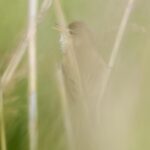It was Day 1 of our big 5 day Spring Bird Tour today, but it didn’t really feel like spring! A very cold north wind meant temperatures have dropped right down again. We were forecast wintry showers today, and they came thick and fast early on this morning so there was barely a gap between them. Thankfully it calmed down a bit by the afternoon and we were able to pack in quite a lot of birding. There was even some blue sky on show! Given the wind, we decided to avoid the coast and head for the relative shelter of inland, down in the Brecks.
Heading south from our base in Wells, we stopped off on the way down in an area which is very good for Stone Curlew. These birds are breeding in farmland, rather than their traditional habitat of grass heath. Scanning across an area of fallow ground, we quickly got on to a Stone Curlew. It was huddled down against the wind, half hidden by the growing vegetation, and back onto us at first. Eventually it shifted round a little so that we could see its black-tipped yellow bill and yellow iris – before it closed its eyes again. A Brown Hare was hiding in the grass here too.
Then some dark clouds appeared over us and it started to rain, rapidly turning to hail. We sheltered in the car for several minutes while it blew through, and then came out for another go. We could still see the Stone Curlew tucked down in the grass, so we decided to see if we could get a better view from a different angle. A couple of Skylarks had started singing, hovering up high into the sky. A bright yellow-headed male Yellowhammer was feeding in a bare strip on the edge of a field. Several Lapwings were flying round. We couldn’t see the Stone Curlew at all from here, with too much tall grass now obscuring our view. Another shower was rapidly arriving, so we hurried back to the car and decided to move on.
We continued south, stopping again briefly to scan some pig fields. A Red Kite was circling distantly over the village. A pair of Grey Partridge appeared from among the pig arcs, but the tractor which had been feeding the pigs disturbed them. They scuttled away quickly out of view. The sky behind us turned black again and another squally shower came in fast, so we got back into the car and set off again.
It was still raining when we arrived at our next destination. We stopped on the roadside and listened, from the warmth and comfort of the car. The first bird we could hear singing was a Willow Warbler, a sweet descending scale. Then a Blackcap started up too, very flutey and melodic, and a Common Whitethroat began singing its own scratchy song nearby. These were all completely outclased when a Nightingale started singing. It was beautiful just to listen to, but we had a tantalising glimpse of a shape moving in the tree from which the sound was emanating.
Thankfully the rain dried up and it started to get brighter. We parked the car and went for a walk. Back along road, two Nightingales were singing now. It was a stereo Nightingale show, with one either side. What a performance! But they just wouldn’t show themselves and eventually one went quiet and the other moved further in, away from us.
We walked on over the Common, across to the other side where more Nightingales had been singing recently. On the way, a Green Woodpecker flushed from the grass, but flew off behind the bushes out of sight. When we arrived where the Nightingales should be, it was quiet at first. However, as the sun started to show itself, a Nightingale started singing. Just as we got to the other side of the bushes, and could see it perched on a bare branch, some dog walkers appeared and it flew back into cover. It felt like it wasn’t going to be our day.
There is an area in the middle of the brambles and gorse where this Nightingale sometimes feeds. We found a spot from where we could see the ground and waited. We could hear it croaking in the brambles and the next thing we knew, it flew up into an oak tree right next to us and started singing. Great views! It hopped around between the branches for a while, singing all the time. When it flicked across to a low hawthorn bush, it landed with its back to us with its tail spread, which caught the sun, a stunning orange-red. Quite a show!
 Nightingale – eventually put on an amazing show for us
Nightingale – eventually put on an amazing show for us
There was a Lesser Whitethroat singing in the brambles nearby. We tried to get a look at it, but it wouldn’t sit still. It kept flying off and then coming back to the same clump, perching only briefly before diving back in. At least we all got good flight views. A Willow Warbler was more obliging. It had been a lovely bright, sunny spell but once again we could see more dark cloud approaching, so we retreated back to the car.
Our next destination was Lakenheath Fen. The dark clouds followed us and there was a mercifully brief shower when we arrived at the visitor centre. We spent a few minutes watching the feeders – there were several Reed Buntings, males and females, a few Goldfinches and even a couple of Greenfinches here today.
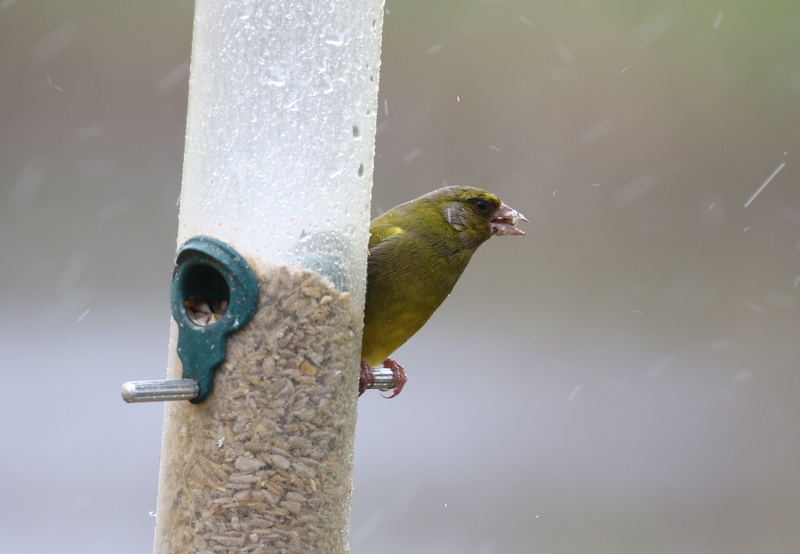 Greenfinch – on the feeders, in the rain
Greenfinch – on the feeders, in the rain
Once the shower had passed overhead, we decided to have a look out over the Washland. It hadn’t been there when we were watching, but when we came outside we flushed a Great Spotted Woodpecker from the feeders. A Cetti’s Warbler shouted at us from the bushes on the way.
The first bird we set eyes on at the Washland was the Glossy Ibis, over in the far corner. We got a good look at it through the scope, noting its distinctive long, thick, downcurved bill. This bird has been here for almost three weeks now – a nice one to see here, though it is commoner in its normal home in southern Europe.
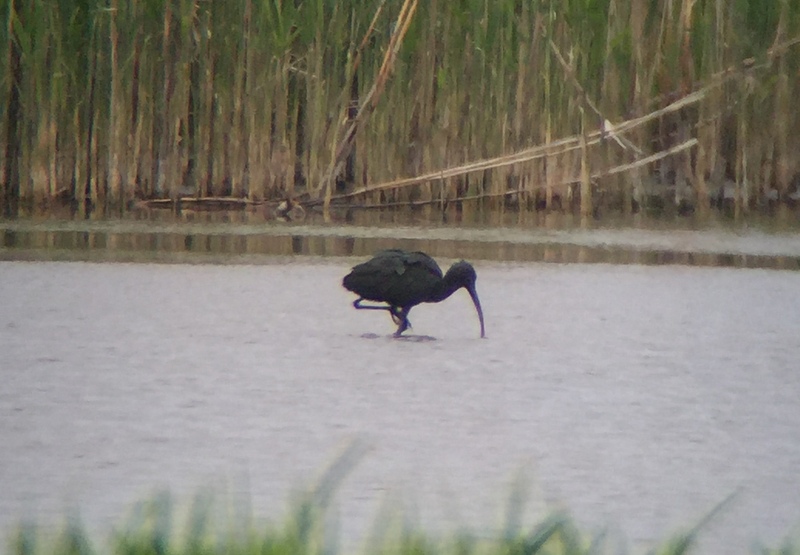 Glossy Ibis – out on Hockwold Washes again today
Glossy Ibis – out on Hockwold Washes again today
Otherwise, there were fewer ducks on here today – just a handful of Teal and Mallard. There were a few Black-tailed Godwits out on the water. And a Sedge Warbler was singing from the reeds just below us, where we could see it. When yet another shower blew in, we hurried back to the shelter of the visitor centre for lunch.
Over lunch, we sat and watched the feeders again. There were much the same birds as we had seen earlier, but when we had jut about finished the Great Spotted Woodpecker finally came back in, so we could get a good look at it.
 Great Spotted Woodpecker – back on the feeders during our lunch break
Great Spotted Woodpecker – back on the feeders during our lunch break
After lunch the rain finally cleared and it looked to be brightening up nicely. We walked out onto the reserve to see what else we could see. A Cuckoo was singing from the trees behind New Fen Viewpoint, which we could hear as we walked up along the main track. It seemed to be deep in some leafy poplars but, when we continued on along the path towards the river bank, the Cuckoo helpfully came out into the top of a bare tree where we could see it. Through the scope, we admired its barred underparts.
 Cuckoo – finally came out into the top of a bare tree
Cuckoo – finally came out into the top of a bare tree
Otherwise on New Fen, there were several Reed Warblers singing. A pair of Tufted Ducks and a couple of Teal were out on the water from viewpoint, along with a family of Coot. A smart male Marsh Harrier was quartering over the reeds at back. By the pond dipping platform, a cracking summer plumage Great Crested Grebe swam out from the reeds not far from us.
 Great Crested Grebe – swam out in front of us by the new pond dipping platform
Great Crested Grebe – swam out in front of us by the new pond dipping platform
There were no hirundines feeding over the reeds at New Fen in the wind today, but a trickle of Swallows and House Martins passed overhead as we were leaving. Further on, we found more of them, gathered on the south edge of West Wood, in the lee of the trees, hawking for insects. One Common Swift appeared with them briefly, zipping back and forth a couple of times, before disappearing off over the trees.
Suddenly a larger shape appeared low over the reeds and scythed up through the throng. It was a Hobby. The hirundines all scattered, alarm calling, as the Hobby disappeared, empty handed, off into trees. A brief view but an all-action moment. Another smart male Marsh Harrier then kept us company on the walk on to Joist Fen, circling over the reeds beside the path. It looked stunning in the sunlight as it banked, against the dark clouds of another shower which was mercifully passing us by in the distance.
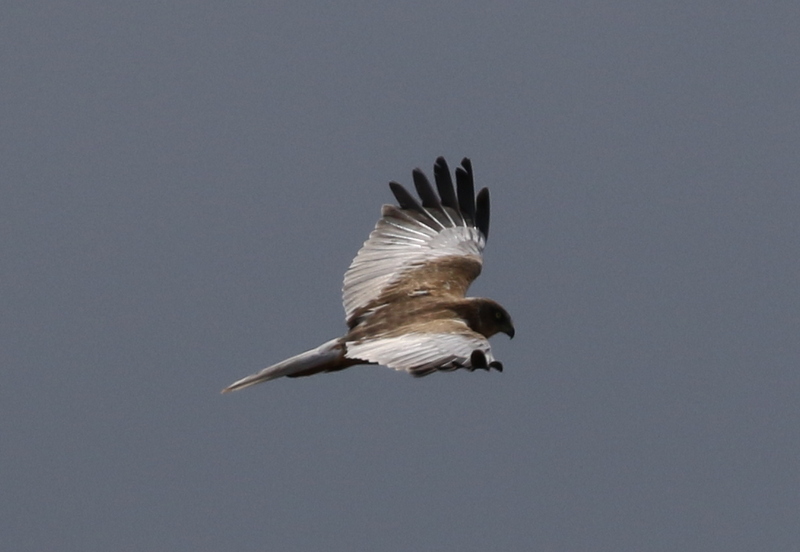 Marsh Harrier – catching the sun against a dark shower cloud in the distance
Marsh Harrier – catching the sun against a dark shower cloud in the distance
Out at the Joist Fen Viewpoint, there were more hirundines hawking low over the reeds. A couple of Sand Martins zipped past. There were no more Hobbys out here today, perhaps it was just too windy. Several Marsh Harriers were circling, but there was no sign of a Bittern today. Once we had recovered our breath, we set off again. After a quick look up on the river bank, which was rather windy, we started to walk back.
As we passed New Fen again, another Hobby came over the trees and across the path, before dropping down towards the reeds. As it turned, we could got a good view of its red trousers. The Cuckoo was still singing in trees and we heard a Treecreeper in the poplars too, although it went quiet before we got up to where it had been.
Although we had seen a Stone Curlew earlier in the day, we would like to have had better views. We drove round to another site where they breed, this one a traditional heathland site. As we drove up, a male Linnet was singing on the fence, while a female fed nearby. A male Stonechat flicked between fenceposts ahead of us. It had brightened up nicely now and there was no sign of any more rain here.
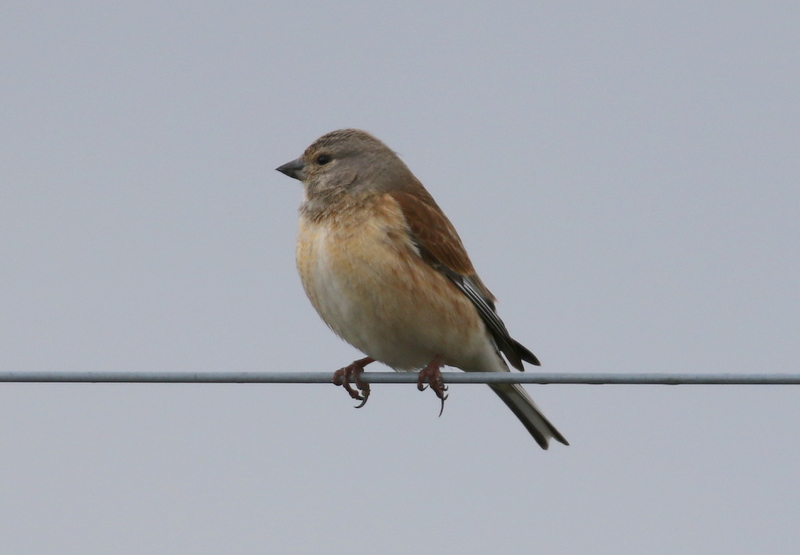 Linnet – this male was singing from the fence
Linnet – this male was singing from the fence
As soon as we got out of the car we immediately spotted a Stone Curlew. Perhaps because of the rain earlier, it was very active and put on quite a show. It was walking round, quite quickly at times, then standing still and looking down at the ground. Occasionally it would peck at something, before setting off again. Through the scope we got a great look at it.
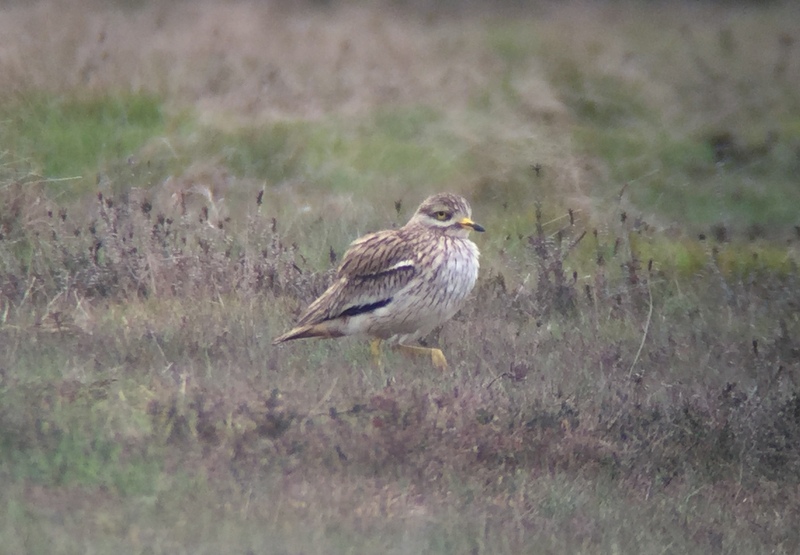 Stone Curlew – feeding actively this afternoon, once the rain cleared
Stone Curlew – feeding actively this afternoon, once the rain cleared
While we were watching the Stone Curlew, a quick scan of the surrounding heath produced a single male Wheatear out on a cultivated strip. It was rather distant but still nice to see here. Wheatear used to be a fairly common breeding bird in the Brecks, but the population has all but died out – this could have been a migrant, but it is nice to think it might be staying to breed. A pair of Grey Partridges were feeding out in the grass too.
Having lost some time because of the rain this morning, it was now getting late. Still we wanted to just have a quick look in at Lynford as the weather had improved. It was quiet at first, perhaps still a bit too cold in the trees. A Mistle Thrush flew out of the tops calling, a distant Nuthatch was piping, and we could hear just a single Goldcrest singing. At the feeders by the gate, a lone Coal Tit was feeding on the fat balls. Down by the bridge, there were no seeds on the posts today and consequently just a single Chaffinch here at first.
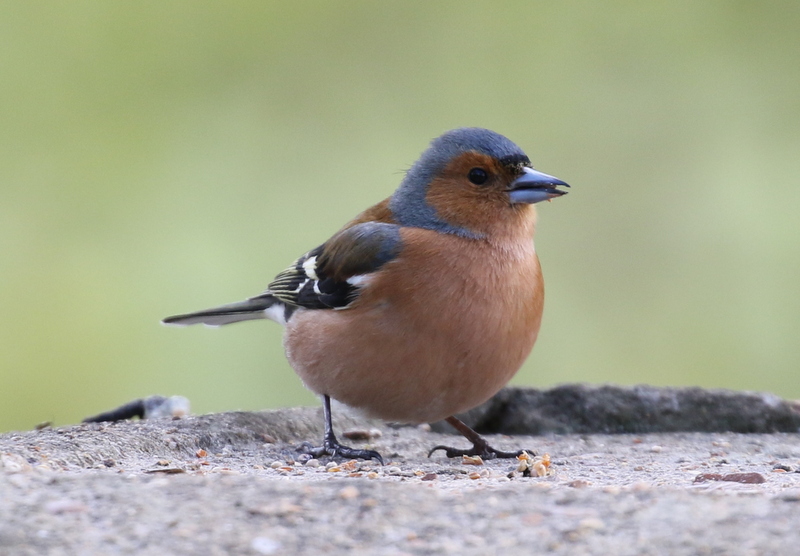 Chaffinch – looking for any remaining seeds around the bridge
Chaffinch – looking for any remaining seeds around the bridge
Then we heard a loud ‘chacking’ call and looked up to see a Fieldfare in the trees, with a second calling nearby. Fieldfares are winter visitors, so these should be thinking about heading back to Scandinavia soon. A Nuthatch appeared in the trees above the bridge, climbing up the trunk into the top before flying off towards the Arboretum. A couple of Siskins flew overhead calling.
Down at the lake, we got a good look at a Little Grebe, diving by one of the islands. There were also several Canada Geese and Mallard. A Marsh Tit started calling behind us, and we turned round to find a pair in the trees. The male was collecting food and taking it back to the bushes to feed the female.
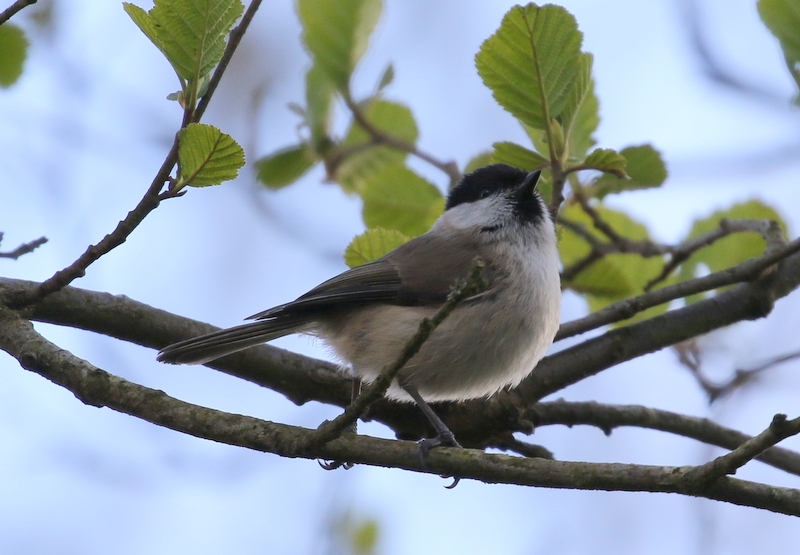 Marsh Tit – collecting food in the trees by the lake
Marsh Tit – collecting food in the trees by the lake
As walked back towards the bridge, as well as the Fieldfares, we could now hear Ring Ouzels calling from the edge of the paddocks. Three flew up into the nearest hornbeam, but unfortunately did not hang around for long, and flew off towards the other end of the lake. We turned round again and walked back to see if we could see them. A Treecreeper appeared in the trees in front of us.
As we walked along the path by the lake, we could hear the Ring Ouzels calling in the alders. Then we flushed one from the tops, and it flew out to the far corner of paddocks, and landed it a line of trees. We got it in the scope, but it was a rather dull female, with no white crescent, and we were looking in to the light. When she flew a short distance down along the line of trees, we realised that the other Ring Ouzels were there too. They all landed briefly together, but just as we got them in the scope, they all flew off towards the Arboretum, calling. Ring Ouzels are just migrants passing through here, most often seen on the coast, and always a good bird to find so far inland.
Then, with a big drive back to North Norfolk still, we had to tear ourselves away. Despite the rain at times, it had been a very successful day.
